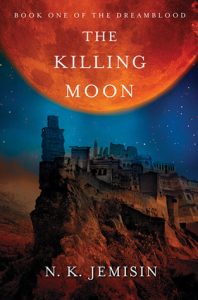The Killing Moon by N. K. Jemisin
 The Killing Moon is a fantasy tale set in a region based loosely on ancient Egypt and Nubia. The author uses delicate prose to weave a sad, captivating tale of love, loss and loyalty against a backdrop of religious conflict and political intrigue.
The Killing Moon is a fantasy tale set in a region based loosely on ancient Egypt and Nubia. The author uses delicate prose to weave a sad, captivating tale of love, loss and loyalty against a backdrop of religious conflict and political intrigue.
The plot of The Killing Moon revolves around an innovative system of magic based on a combination of Freudian dream theory and ancient Egyptian medicine. The idea is that there are four natural by-products of dreaming: dreambile, dreamblood, dreamichor and dreamseed. Each of these can be harvested from anyone, and each has its own uses in religious healing, but the most rare and valuable is dreamblood. Dreamblood is produced at the moment of death, and can only be collected by Gatherers, who are essentially assassins completing contracts submitted to their order, the Hetawa. However, unlike most fantasy assassins, Gathering is mostly a peaceful art, and many of the victims, or ‘tithebearers’, are old or sick people who submitted the request to be Gathered on their own behalf, or that of a loved one. Jemisin uses vastly different character perspectives on the art of Gathering to explore, but not dwell on, what is essentially a moral debate about the ethics of euthanasia, and uses this as the foundation of the cultural differences between the warring states of Gujaareh and Kisua.
With a few exceptions, the story is told from the point of view of three main characters: Sunandi, a Kisuati ambassador trained in the art of negotiation and spying; Ehiru, the most revered Gatherer in Gujaareh; and Nijiri, Ehiru’s apprentice and closest friend. Each of the characters is likeable in their own way, and each hold different views, coming into conflict in a number of ways. However, I didn’t really feel much of a connection with any of them, and felt that the formal traditions and heavy focus on religion kept the characters at a distance, particularly Ehiru and Nijiri. I felt that they could perhaps have been developed more as individuals, despite the relatively short length of the book and the confines of the story.
The plot itself is intriguing, if fairly straightforward. A series of mysterious and horrific murders can mean only one thing: a Reaper – a monster possessing abilities that are a twisted perversion of a Gatherer’s own – is loose in the dark streets of Gujaareh. Somehow, its appearance is connected to both the royal Prince and the Hetawa, and an investigation into its origin reveals even darker plots of corruption and impending war. The characters’ journey of discovery throughout the novel is an intriguing and pleasant read, with a couple of twists and turns along the way. The pacing is steady and fluid, although the author foregoes much of the action, choosing instead to focus on the internal conflict of both Ehiru and Nijiri. For the most part this is fine, as there are plenty of beautiful moonlit cityscapes and evocative dream sequences to fill the imagination. However, there are two major conflicts towards the end, both of which happen entirely off-page, making the aftermath and epilogue somewhat anticlimactic and leaving me feeling a bit hollow.
Despite this, I look forward to reading book two in this duology, The Shadowed Sun. I enjoyed the writing style and flowing pace of The Killing Moon, and in spite of the disconnect I felt with the characters, I was thoroughly immersed in Jemisin’s world.
